Jerusalem, The Old City, Kotel, etc. etc.
etc!
Day Two - Tuesday July 4th 2006 –  - Yom Shlee-she
- Yom Shlee-she
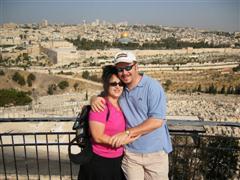 Amazing, absolutely amazing day! We took on Jerusalem the Old City today among so many other great sites, and not once did I even think about the fourth of July being independence day back in the United States. I did however, make the realization, that July 4th, a day of independence in the states, will forever be the day that I first saw the Wailing Wall, the day that I walked the streets of Jerusalem, and so many other events. Amazing, absolutely amazing day! We took on Jerusalem the Old City today among so many other great sites, and not once did I even think about the fourth of July being independence day back in the United States. I did however, make the realization, that July 4th, a day of independence in the states, will forever be the day that I first saw the Wailing Wall, the day that I walked the streets of Jerusalem, and so many other events.
First we went up to Mt. Scopus, and over to the Mount of Olives to view the old city from the eastern side. Overlooking the valley of Kidron, and over to the old city, the view was absolutely breathtaking! I cannot describe it in words, one must see this view for themselves. However I will try. In front of us was the most historically significant city religiously, politically, and emotionally for scores of millions over thousands of years, in the world.
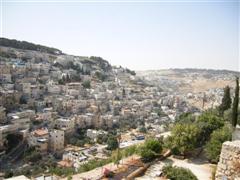 As far as you can see, were houses and structures, some old, some more modern.
You can stare in one direction for a long while and not even be able to take in the depth
and the detail of all that is in front of you. The vastness that is
Jerusalem, is quite overwhelming. There are so many homes, temples, mosques, tombs etc. As far as you can see, were houses and structures, some old, some more modern.
You can stare in one direction for a long while and not even be able to take in the depth
and the detail of all that is in front of you. The vastness that is
Jerusalem, is quite overwhelming. There are so many homes, temples, mosques, tombs etc.
The valley separates the living (Jerusalem)
from the dead, which are represented by the mass of tombs on the other
side of the valley on the Mount of Olives. The people that are buried
there are the closest to Jerusalem and arguably the first ones to be “resurrected”
according to Talmudic tradition when Moshiach comes.
The stone that Jerusalem is made from is
called “Jerusalem stone” and is limestone that is excavated locally
from various quarries. It is very similar to the stone that is used at
Virginia Tech which is made of sandstone.
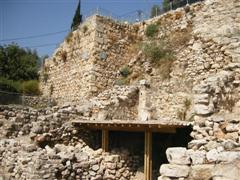 We took a tour of the
City of David
which was the very first settlement of Jerusalem on the south eastern side
of the city. This city was very well fortressed, and protected by a large
hill on the eastern side. The focus of our tour was to discover the
underground water supplies that fed the city. Archeological digs, mostly
by British archeologists, the main one by Charles Warren, We took a tour of the
City of David
which was the very first settlement of Jerusalem on the south eastern side
of the city. This city was very well fortressed, and protected by a large
hill on the eastern side. The focus of our tour was to discover the
underground water supplies that fed the city. Archeological digs, mostly
by British archeologists, the main one by Charles Warren, 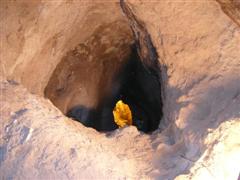 had discovered
several tunnels through which an underground water supply was tapped and
used to sustain life. Hezakiah’s tunnel was used to dam the water
supply and provide for the then “City of David.” Amy Beth and I walked
through these narrow tunnels and loved every minute of it. She looked back
at me the moment that she had to squeeze through a very narrow opening and
was laughing and said, “this is the best part!” had discovered
several tunnels through which an underground water supply was tapped and
used to sustain life. Hezakiah’s tunnel was used to dam the water
supply and provide for the then “City of David.” Amy Beth and I walked
through these narrow tunnels and loved every minute of it. She looked back
at me the moment that she had to squeeze through a very narrow opening and
was laughing and said, “this is the best part!”
 We noticed an Arab boy who
threw out an
empty bottle of water only a few feet from a trash receptacle. We noticed an Arab boy who
threw out an
empty bottle of water only a few feet from a trash receptacle.
Thought: Why would he care about keeping this land
clean? Because, it’s
not his. This seems to be one of my reoccurring thoughts that the Arabs
almost seem to be punishing the Jews by not developing the land, and
taking what they are given and making it worse. There is a significant
difference between the Arab areas and the Jewish areas.
 We entered the Old City through the Zion
gate. We noticed the bullet holes around the gate that were
caused by the Jews in 1948 as they fought the Jordanians for control of
the Jewish Quarter – we will study that more in detail tomorrow. We ate
lunch in the Old City. I had a "shwerma" (it was OK, not as good as I
expected) and Amy Beth had falafel. We entered the Old City through the Zion
gate. We noticed the bullet holes around the gate that were
caused by the Jews in 1948 as they fought the Jordanians for control of
the Jewish Quarter – we will study that more in detail tomorrow. We ate
lunch in the Old City. I had a "shwerma" (it was OK, not as good as I
expected) and Amy Beth had falafel.
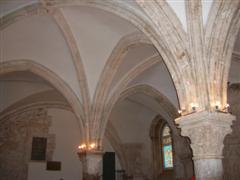 After lunch, we went to
visit the tomb of David. The architecture had many arches, a result of the crusade period. We also visited the symbolic area (not the real area) where apparently the last supper was eaten. After lunch, we went to
visit the tomb of David. The architecture had many arches, a result of the crusade period. We also visited the symbolic area (not the real area) where apparently the last supper was eaten.
The group then was going to go back to the hotel. Amy Beth and I decided to stay in the Old City and meet up with the group after dinner. Great decision!!!
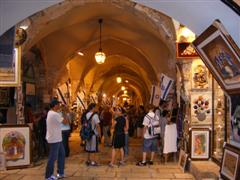 We walked through the
shuk.
At first we walked through the Jewish section. The crafts were
exquisite but expensive. The paintings were mostly originals and
beautifully framed. Since this was our first shopping experience,
and considering the prices, we moved on. We walked through the
shuk.
At first we walked through the Jewish section. The crafts were
exquisite but expensive. The paintings were mostly originals and
beautifully framed. Since this was our first shopping experience,
and considering the prices, we moved on.
 We
then passed an archway, and the Jewish section turned into the Arab
section. There was a complete difference. There was less
light, the shopkeepers were almost exclusively male. The shops were
less ornate and the merchandise was less artistic and more for tourists
and those shopping for textile goods. We
then passed an archway, and the Jewish section turned into the Arab
section. There was a complete difference. There was less
light, the shopkeepers were almost exclusively male. The shops were
less ornate and the merchandise was less artistic and more for tourists
and those shopping for textile goods.
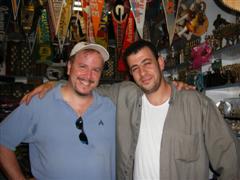 We bargained
with some Arabs for goods. There was one in particular where we bought a
couple of items, named Iyal. We bargained him down from $50 (about 225
shekels) to 70 shekels (about $16) for a nice skirt. I paid him 15 shekels
for a scarf, the nicest fabric he had according to him. He tried to get
us, but we held our ground! We bargained
with some Arabs for goods. There was one in particular where we bought a
couple of items, named Iyal. We bargained him down from $50 (about 225
shekels) to 70 shekels (about $16) for a nice skirt. I paid him 15 shekels
for a scarf, the nicest fabric he had according to him. He tried to get
us, but we held our ground!
The shopkeepers all have an angle to try to
get you to buy from them. They attempt to initiate a
conversation with you as you walk by. "That's a beautiful
color you are wearing my lady! Come, let me give you my card."
We quickly learned how to not fall for their schtick when were
weren't interested.
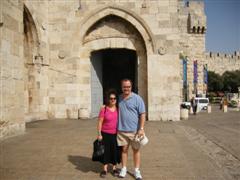 When we came out of the shuk, we just happened to be right next to the Jaffa gate. We
were planning on going to Jaffa gate, but it was coincidental that we came
upon it after our walk through the shuk.
When we came out of the shuk, we just happened to be right next to the Jaffa gate. We
were planning on going to Jaffa gate, but it was coincidental that we came
upon it after our walk through the shuk.
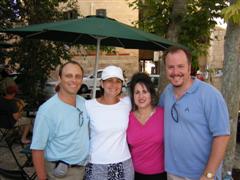 We
took
some pictures and then headed towards the Kotel. As we were on our way, I
heard a voice say “Richard!” I looked back and there was Marcy Jason
Peck Mostoffsky. Now that was a coincidence! We sat down for over a half
of an hour and just caught up with Marci and her husband, of a year and a
half, Michael
Mostoffsky. We
took
some pictures and then headed towards the Kotel. As we were on our way, I
heard a voice say “Richard!” I looked back and there was Marcy Jason
Peck Mostoffsky. Now that was a coincidence! We sat down for over a half
of an hour and just caught up with Marci and her husband, of a year and a
half, Michael
Mostoffsky.
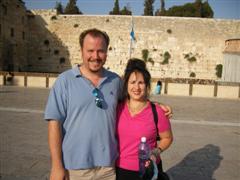 We then went directly to the Kotel. As we
approached the Kotel, there were several beggars who successfully obtained
some tzedakah from us. We went through security to get to the Kotel and
there it was... We then went directly to the Kotel. As we
approached the Kotel, there were several beggars who successfully obtained
some tzedakah from us. We went through security to get to the Kotel and
there it was...
The wall...
The incredible “wailing wall” was before me
for the first time. It was about what I imagined as far as size.
There is a plaza where people can gather and ample area in front of the
wall for davening - at least for the men. The women had about ½ to
1/3 of the space. There is a mechitzah, a separation, between the men's
side and the women's side.
 I walked in and was preparing for an
unbelievable experience. An orthodox man, his name was Ya’akov,
approached me and led me to the wall and asked me to repeat a prayer after
him. He then recited the priestly blessing on me, right there at the wall.
This was a marvelous experience and I was just trying to soak it all
in, when he whispered in my ear, "tzedakah" - charity. He was now
asking for money. I didn’t really have a problem with this, I was
prepared to give some tzedakah. I had already given my own tzedakah on the
way to the Kotel, but I had $10 from Lo that I traveled from Richmond to
give. I walked in and was preparing for an
unbelievable experience. An orthodox man, his name was Ya’akov,
approached me and led me to the wall and asked me to repeat a prayer after
him. He then recited the priestly blessing on me, right there at the wall.
This was a marvelous experience and I was just trying to soak it all
in, when he whispered in my ear, "tzedakah" - charity. He was now
asking for money. I didn’t really have a problem with this, I was
prepared to give some tzedakah. I had already given my own tzedakah on the
way to the Kotel, but I had $10 from Lo that I traveled from Richmond to
give.
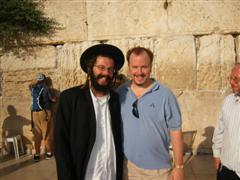 I gave him the money, a $10 bill, and he
looked a bit disappointed, and then said, "but I have
children..." I couldn't believe the guy wasn't happy with $10. This is where I started to feel uncomfortable and that this
cheapened the event for me. A friend of his then started to also hassle me
about money and I just wanted them to leave me alone. I paid his friend 20
shekels, partly to get him to go away. They continued to hassle me and another guy came up
to me to beg, and I said,
“leave me alone!" I gave him the money, a $10 bill, and he
looked a bit disappointed, and then said, "but I have
children..." I couldn't believe the guy wasn't happy with $10. This is where I started to feel uncomfortable and that this
cheapened the event for me. A friend of his then started to also hassle me
about money and I just wanted them to leave me alone. I paid his friend 20
shekels, partly to get him to go away. They continued to hassle me and another guy came up
to me to beg, and I said,
“leave me alone!"
I then went to the wall, by myself, and recited the
Shema and placed a prayer for health, happiness and prosperity for all of
my family with mine and Amy Beth’s entire immediate families mentioned
by name. When I turned to leave, I decided that I should get a picture
with Ya’akov. His friends tried to get more money, but I just turned
them down.
 All in all, the event was meaningful, but it had some disappointing overtones. All in all, the event was meaningful, but it had some disappointing overtones.
We then went for dinner in a café that only
served fish dinners. Even though I really don’t like fish, the food was
OK. We then met up with the group back at the Kotel. This time, I decided
that I would avoid the beggars completely. I went in and observed the
wall, the people, the prayers, the davening, then I went to the wall and
said the whole shema and reiterated the prayer that I had written down.
This was a much better experience.
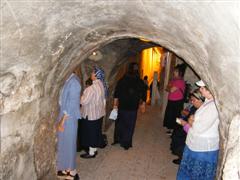 The
group went on the excavation of the western
wall of the temple. The deeper you dig, the more you uncover older
civilizations. They just cover over the ruins of older civilizations and
build on top. It’s amazing how deep the wall goes. The Arabs have done
just about all that they can to conceal the original wall. The only part
of the wall that you can see is about 200 feet across but the wall
actually stretches over 1500 feet! The
group went on the excavation of the western
wall of the temple. The deeper you dig, the more you uncover older
civilizations. They just cover over the ruins of older civilizations and
build on top. It’s amazing how deep the wall goes. The Arabs have done
just about all that they can to conceal the original wall. The only part
of the wall that you can see is about 200 feet across but the wall
actually stretches over 1500 feet!
There was a part of the wall where some
ladies were praying (underneath during the excavation tour) where it was
pointed out that on the other side was the “holy of holies.” That is
as close as anyone can come to that spot, currently. Amy Beth and I took a
snapshot at this spot.
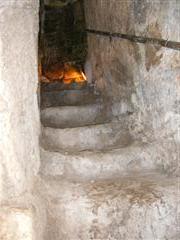 There was no exit for this excavation tour.
Gadi (our guide) explained to us that negotiations for an exit with
some stairs were being made between an Arab shop owner and the
authorities, but Arafat stepped in and denied the permission to the shop
owner. There was another (easily accessible) exit, again Arafat wouldn’t
allow it. We, as everyone else, had to walk back through the entire
exhibit, some 1000 feet or so, through narrow pathways etc. bumping into
people going forward to get out. The exit would put people in the Arab
area of town anyway, but to hell with Arafat for being such an Ogre! Gadi,
asked me why I was so surprised over this, considering he There was no exit for this excavation tour.
Gadi (our guide) explained to us that negotiations for an exit with
some stairs were being made between an Arab shop owner and the
authorities, but Arafat stepped in and denied the permission to the shop
owner. There was another (easily accessible) exit, again Arafat wouldn’t
allow it. We, as everyone else, had to walk back through the entire
exhibit, some 1000 feet or so, through narrow pathways etc. bumping into
people going forward to get out. The exit would put people in the Arab
area of town anyway, but to hell with Arafat for being such an Ogre! Gadi,
asked me why I was so surprised over this, considering he  turned down the
best land/peace deal ever offered. Still I thought this demonstrated his
complete unwillingness to compromise, I mean, come on, it’s an exit
door!!! turned down the
best land/peace deal ever offered. Still I thought this demonstrated his
complete unwillingness to compromise, I mean, come on, it’s an exit
door!!!
We then went to the Fuchsburg Center (the
center for Conservative Judaism located in Jerusalem) and saw
Menachem Creditor who was performing guitar and singing with another rabbi
for some USY students. They were very entertaining, especially when
singing their original song "Shabbos Elevator."
We went to a Supersol (a grocery store), bought a
few things and came home. It’s better to come early, stay late and take
it all in. This was just the first full day, I mean, who needs to sleep in
Jerusalem!!!
[ Back ] [ Up ] [ Next ]
|